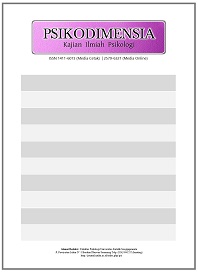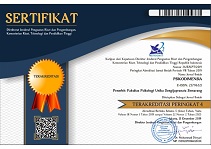HUBUNGAN ANTARA KESEPIAN DAN MOTIF PERSAHABATAN DENGAN KOMUNIKASI ON LINE PADA REMAJA AKHIR
Abstract
motive; and on line communication on adolescence. We use questionnaires
of loneliness, friendship motive and on line communication, to collect the
data. The sum of subjects in this research are 286 adolescences ( 86 men
and 200 women ). We analysis data with correlation technique. Found,
there are negative correlation between loneliness and friendship motive (r =
-. 439, p = .000 < .01), there are negative correlation between loneliness and
on line communication ( r = -.154, p = .009 < .05), there are correlation
between motive friendship and on line communication (r = .358, p = .000 <
.01).
Keywords
Full Text:
PDFReferences
Baron, R.A & Byrne, D. (2004). Social Psychology. (10th edition). Boston: Allyn and Bacon.
Bausmeister, R. F and Vohs, K. D. (2007). Encyclopedia of Social Psychology. Los Angeles: A Sage Publications.
Beebe, S.A, Beebe, S.J & Redmond, M.V. (2005). Interpersonal Communication. (4th edition). Boston: Person.
Collin, N.J. (2007). Adolescence: Continuity, Change and Diversity. Boston: McGraw-Hill.
Dariyo, A. (2015a). Kecerdasan Emosi, Persahabatan dan Kepuasan Hidup Remaja. (Laporan penelitian, tidak diterbitkan) Jakarta: Lembaga Penelitian dan Publikasi Ilmiah Universitas Tarumanagara.
Dariyo, A (2015b). Ketrampilan Organisasi, Kecerdasan Emosi dan Persahabatan. Dalam Prociding “ Perkembangan Manusia dan Kesejahteraan Psikologis”. Malang: Direktorat Program Pascasarjana Universitas Muhammadiyah.
Dariyo, A. (2016). Role of Emotional Intelligence on Chinese Indonesian Adolescence Life Satisfaction. Abstract of The Third International Conference on Chinese Indonesian Studies, March 16-17, 2016.
Daly, J. A., (2002). Personality and Interpersonal Communication, in Knapp, M.L & Daly, J.A. Handbook of Interpersonal Communication (3rd Edition). London, UK: Sage Publication.
DeVito, J.A. (2011). Interpersonal Messages: Communication and Relationship Skill. Boston: Allyn & Bacon.
DeVito, J. A. (2013). The Interpersonal Communication Book. Boston: Pearson.
Griffin, E.M. (1997). Communication theory. (3rd edition). New York: McGraw-Hill.
Hagie, B & Dickson, D. (2004). Skilled Interpersonal Communication. (4th edition). New York: Roudledge.
Hapasari, A dan Primastuti, E. (2014). Kepercayaan Diri Mahasiswi Papua Ditinjau dari Dukungan Sosial Teman Sebaya. Psikodimensia, Kajian Ilmiah Psikologi, 13 (1), 60-72.
McKenna, K. Y & Bargh, J. A. (1998). Coming out in the age of the internet: Identity “ demarginalization” through virtual group participation. Journal personality and social psychology, 75, 681-694.
Mesch, G. (2005). A study of adolescents’ online and offline social relationships. Research Report. Oxford Internet Institute. No. 8, 1-24.
Moller, K & Statin, H. (2001). Are Close relationship in adolescence with partner relationship in midlife ? A Longitudinal perspective study. International Journal Behavior Development, 25 (1), 69- 77.
Papalia, D.E, Olds, S.W & Feldman, R.D. (2011). Human Development. (eleventh edition). Boston: McGraw-Hill.
Destianingrum, E. dan Widiyatmadi, E (2011). Perilaku Penggunaan Jejaring Sosial Facebook pada mahasiswa Ditinjau dari Kebutuhan Afiliasi. Psikodimensia, Kajian Ilmiah Psikologi, 10 (1), 82-93.
Ramdhani, N. (2011). Kajian Psikologis Mengenai Komunikasi Berbasis Paperless Office. Jurnal Psikologi Fakultas Psikologi Universitas Gadjah Mada, 38 (2), 115-133.
Rozali,Y, A. ( 2015). Kecerdasan Interpersonal Ditinjau dari Penerapan Pola Asuh Orangtua. Dalam Prociding “ Perkembangan Manusia dan Kesejahteraan Psikologis”. Malang: Direktorat Program Pascasarjana Universitas Muhammadiyah.
Russel, D., Peplau, L. A., and Ferguson, M. L. (1978). Developing a Measure of Loneliness. Journal of Personality Assesment, 42 (3), 290-294.
Russel, D., Peplau, L. A., and Cutrona, C. E. (1980).The Revised UCLA Lonelines Scale: Concurent and Discriminan Validity Evidence. Journal of Personality and Social Psychology, 39 (3), 472- 480.
Santrock, J.W. (2007). Adolescence. Boston: McGraw-Hill.
Steinberg, L. (2011). Adolescence. (10th edition). New York: McGraw-Hill.
Subrahmanyam, K and Greenfield, P. (2008) Communicating Online: Adolescent Relationships and the Media. Future of Children, 18 (1 ), 1-27.
Utami, D. A. (2015). Kepercayaan Interpersonal dengan Pemaafan dalam Hubungan Persahabatan. Jurnal Ilmiah Psikologi Terapan, 3 (1), 54-70.
Van den Eijnden, R.J.J.M, Meerkerk, G.J, Vermulst, A.A, Spijkerman, R & Engel, R.C. M.E (2008). Online Communication, compulsive Internet Use, and Psychological Well Being among adolescence: A Longitudinal Study. Development Psychology, 44 (3), 655-665.
Velkenburg, P. M & Peter, J. (2007). Preadolescence and Adolescence’ Online Communcation and Their Closeness to Friends. Developmental Psychology, 43, -267-277.
Valkenburg, P.M. and Peter, J. (2009). Social Consequences of the Internet for Adolescents: A Decade of Research. Current Directions in Psychological Science. 1- 18.
Wolak, J Mitchell, K.J. and Finkelhor, D. (2003). Escaping or connecting? Characteristics of youth who form close online relationships. Journal of Adolescence, 26, 105–119.
Yusuf, N. F. (2015). Pengaruh Kesepian terhadap Depresi pada Remaja. Dalam Prociding “ Perkembangan Manusia dan Kesejahteraan Psikologis”. Malang: Direktorat Program Pascasarjana Universitas Muhammadiyah.
DOI: https://doi.org/10.24167/psiko.v15i2.990
Print ISSN : 1411-6073 | online ISSN : 2579-6321 View My Stats

This work is licensed under a Creative Commons Attribution 4.0 International License.




















